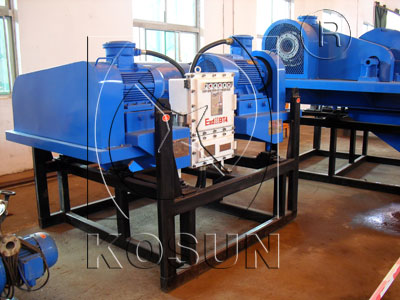Decanter centrifuge working principle by Kosun
2013-07-18
In order to fully understand how a decanter centrifuge operates, we must first define what a centrifuge does. In many industrial jobs, solid material often mixes with liquids, contaminating water supplies or turning mud into sludge. A decanter centrifuge is useful in that it separates solids and liquids, and has become an essential component of water waste facilities and the chemical, oil, and food processing industries.
There are several types of decanter centrifuges currently utilized in the industry, the most common of which are vertical, horizontal and conveyor centrifuges. The principle behind a decanter centrifuge is based on the theory of gravitational separation. For example, if you fill a glass with a mixture of mud and water, over time the weight of the mud will cause it to settle down at the base of the glass. With the mud congealed at the bottom, the water will be forced upwards, creating a clear separation between the two.
A decanter centrifuge employs the same principles of gravitational force. However, unlike the glass mixture, the process is expedited through the use of continuous rotation. In fact, rotation provides anywhere from 1000 to 4000 times the normal gravitational force, reducing the time required for separation from hours to seconds.

The concept of rotational separation is similar to rides found at amusement parks and county fairgrounds. In these rides, placing yourself at an angle allows you to overcome the gravitational forces induced by rotation. Similarly, a decanter centrifuge is essentially a bowl tube that rotates at an extremely high speed. The bowl tube is equipped with an internal conveyor which moves in the same direction but at a different velocity.
Decanter centrifuge working principle
Step 1: The slurry is inserted into the centrifuge through a connecting pipe and onto a conveyor.
Step 2: Utilizing an internal feed compartment, the conveyor ushers the slurry through a nozzle into the bowl area.
Step 3: The bowl rotates at high speeds to induce gravitational forces.
Step 4: High speed rotation separates the solid material from the liquid in a matter of seconds.
Step 5: The conveyor delivers the solid material upwards where it is discharged through a nozzle.
Step 6: The solid material removed, the purified liquid is released from a separate output.
The ability to purify a liquid makes decanter centrifuges ideal for waste water treatment facilities. However, there are variety of industries for which such centrifuges play an important role. Similar to other decanter equipment, centrifuges are simple to install and do not require a foundation to build upon. Their efficiency saves time and materials and is an essential component for many blue collar industries.
News
- 07-11Technical features of using KOSUN drilling waste mud treatment system
- 07-07Main equipment of solids control system in drilling
- 06-26Geothermal well mud treatment system manufacturer—KOSUN solid control
- 06-26The key to achieving mud zero discharge is on-site processing after solid-liquid separation
- 05-10Application Scenarios of KOSUN Drilling Waste Treatment Equipment
- 05-10Environmental protection new regulations require to achieve zero discharge of drilling waste
- 05-09KOSUN Solid-liquid Separation Equipment is used in the construction industry
- 04-19What are the main functions of the Mud Agitator during use?
- 04-15The Advantages of KOSUN's trenchless horizontal directional crossing mud recovery system
- 03-15Vacuum degasser is mainly divided into centrifugal degasser and jet degasser




